Known for their decor, ambiance and fascinating backstories, each of these historic European cafes is dripping with history and tradition.
Where better to sip on a coffee or snack on a local sweet than a beautiful coffee house where you can soak up local culture at the same time.
Some of these iconic cafes were frequented by famous literati. Others were the birthplace of revolution. While some are known for their opulent interiors, others are humble local joints. Each has its own particular charms – and most boast their own signature beverage or cake.
Here are 17 of the most beautiful historic European cafes you have to try at least once, as recommended by travel writers.
- Prefer tea instead? Check out my list of the top destinations around the world for tea lovers.
Please note: This post contains affiliate links, meaning I may earn a commission if you make a purchase by clicking a link (at no extra cost to you). Learn more.
Les Deux Magots | Paris, France
By Elisa at World in Paris
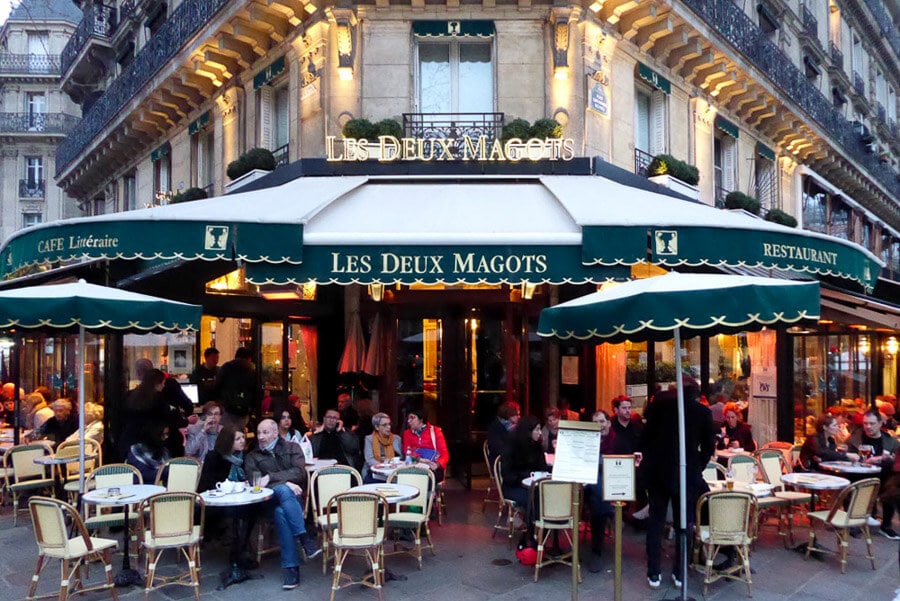
If you plan to spend 3 days in Paris or more, take the time to indulge in a few coffee houses. The French capital boasts hundreds of beautiful cafes, many of them also part of the city’s history.
Les Deux Magots (established in 1822) in Saint Germain-des-Près is one of the most iconic cafes in Europe. After the Second World War, Saint Germain became the centre of intellectual and cultural life in Paris, and cafes like Les Deux Magots emerged as the perfect meeting places for animated discussions.
Les Deux Magots was Hemingway’s favourite cafe in Saint Germain. It’s said that he spent many hours here writing or drinking with fellow authors including James Joyce and F. Scott Fitzgerald. Les Deux Magots hasn’t changed much, and it still attracts personalities from the worlds of art, literature, fashion and politics.
Depending on the time of day, you should opt for a coffee or a hot chocolate, or a glass of one of the cafe’s excellent wines.
Caffe Florian | Venice, Italy
By Alex at Alex on the Map
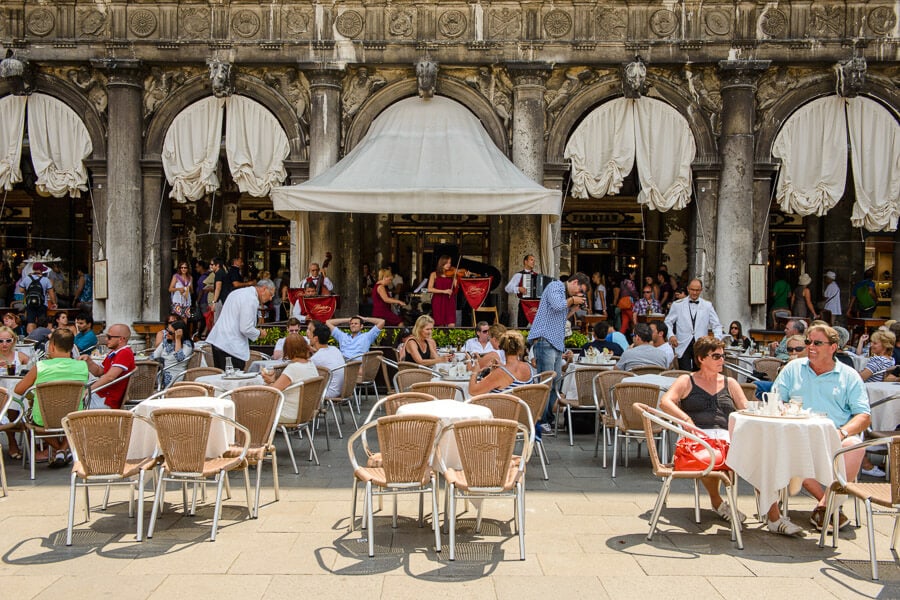
Known for being the most iconic and oldest cafe in the gorgeous city of Venice (and according to the claims, the oldest cafe in all of Europe!), Caffe Florian has been a fixture of Piazzo San Marco since 1720.
It takes its name from the owner, Floriano Francesconi. Part of the reason this beautiful cafe remains a must-do in Venice is because it was created during a pivotal time in the Republic’s history. Back in the day, it was a meeting place for conspirators against the French and Austrian rulers who took over after the fall of the Venetian Empire.
Today, you can still visit Caffe Florian’s opulent rooms. Not much has changed since its founding: it still contains its original wall murals, and the menu remains much the same as it has for the past several hundred years. Recently, the owners have tried to bring the cafe into the 21st century by showcasing contemporary art exhibits as well.
The hot chocolate (cioccolata calda in Italian) is divine, and you can’t go wrong with an espresso or cappuccino.
New York Cafe | Budapest, Hungary
Editor’s choice
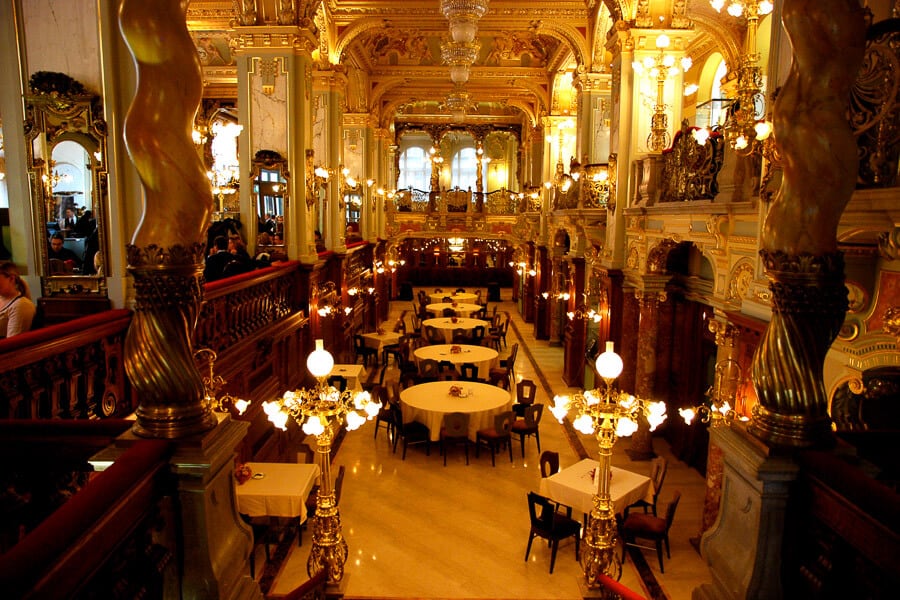
A classic European coffeehouse that oozes old-world charm, Budapest’s New York Cafe boasts one of the most opulent interiors of any cafe on this list. It really must be seen in person to be believed.
The cafe is located on the ground floor of the luxury New York Palace Hotel. The building’s intricate facade is your first clue to the treasures that lay inside: hardwood railings, chandeliers and a generous use of marble give this cafe a truly palatial feel.
New York Cafe embodies Hungary’s beauty and old-world charm; if this is your style, you’d do well to choose an Airbnb in Budapest that channels the same sense of glamour.
As well as being easy on the eye, the cafe has played an important role in Hungarian history. Writers and editors flocked here at the turn of the 20th century, and one of the country’s most important newspapers was edited right here in the upstairs gallery.
In the post-war period, the cafe fell into disrepair – it was only as recently as 2006 that New York Cafe was lovingly restored to its former glory.
Order the signature afternoon tea, an extravagant spread of sandwiches and sweets served with coffee. Or you can upgrade to a glass of Prosecco!
Café A Brasileira | Portugal
By Wendy at The Nomadic Vegan
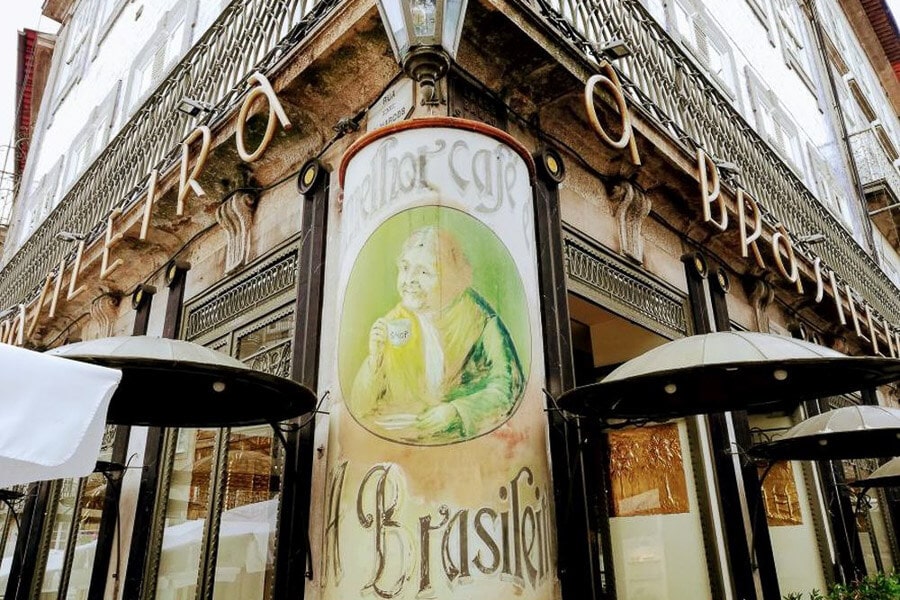
This historic cafe first opened its doors in Porto in 1903, and by 1907 the owner had expanded the business to Lisbon and Braga. In the beginning, it wasn’t really a cafe, but rather a place that sold coffee beans imported from Brazil. Back then, Portuguese people didn’t yet have the habit of drinking coffee in public establishments. It was A Brasileira that started this trend!
The owner, Adriano Telles, offered a free cup of coffee as an incentive to anyone who purchased coffee beans from his shop. This was the first place that sold the now ubiquitous Portuguese bica, which has become a national passion.
Similar to Italian espresso, the word bica is an acronym that stands for beba isto com açúcar (‘drink this with sugar’). Customers didn’t like the strong, bitter taste at first, so Telles put signs on the tables instructing them to add sweetener.
Today, A Brasileira is a top attraction in Braga, Porto and Lisbon for its ambiance and history – but not necessarily for its food, especially if you’re vegetarian or vegan.
Prices here are a bit high by Portugal standards, so most locals just order a bica, which costs 2 Euro.
Cafe Maiasmokk | Tallinn, Estonia
By Katja at Globe Totting
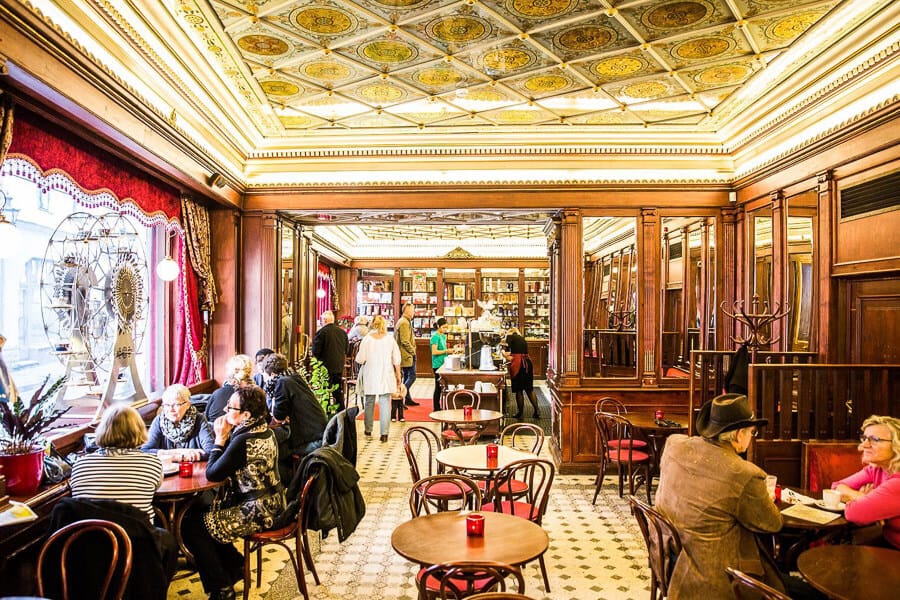
Charming Cafe Maiasmokk is the oldest cafe in Tallinn and indeed in Estonia.
It was first established in 1864 by Georg Stude, a Baltic German confectioner who was responsible for creating the best marzipan in town. His marzipan treats were so exquisite, they were favoured by the Russian Imperial family and its court.
Today, marzipan remains one of the main reasons to visit Cafe Maiasmokk – there are dozens of marzipan figures on display in the shop window.
If you want to learn more about this traditional sweet – like how it was used during the Middle Ages as a cure for lovesickness – then make sure to visit the mini marzipan museum on site. It’s home to around 200 figures, all made from moulds dating back over 100 years. This is a particularly fun thing to do in Tallinn with kids.
Of course, there’s more to Maiasmokk than just marzipan.
The cafe is a wonderful ‘step back in time’, having remained largely unchanged since 1913. It’s a great place for breakfast and lunch, or you might just want to stop by for coffee and cake. Whatever you do, don’t forget to look up at the ceiling!
Atlas Cafe | Lviv, Ukraine
By Kami at Kami and the Rest of the World
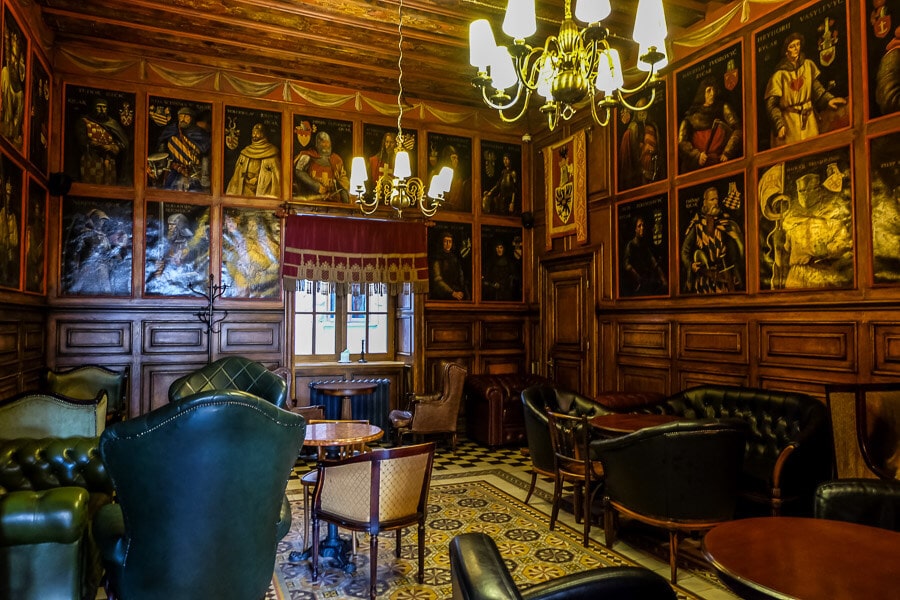
Cafe-hopping is one of the best things to do in Lviv, Ukraine. There are so many exceptional cafes located all over the city (Lviv has the highest number of cafes per capita in the world, allegedly!), but one of them deserves more attention than the others.
Atlas Cafe is located at the corner of Rynok Square and Drukarska Street, a favourite hangout for Lviv’s artistic community in the days before WW2. Today, it’s one of the most popular and beautiful Lviv cafes where you can get a delicious breakfast, lunch or dinner as well as of course, coffee.
While it’s tempting to sit outside and observe Lviv’s street life, you should see the interior of the cafe too. Parts of the decor are original and you can see numerous references to the pre-war era.
The most beautiful room is hidden on the righthand side of the building – the lights are dim, the armchairs are super comfortable, and the space is decorated with paintings of knights.
Fortunately, prices at Cafe Atlas are affordable and the place is large enough that there is almost always a free table available.
Cafe Louvre | Prague, Czechia
By Rose at Where Goes Rose
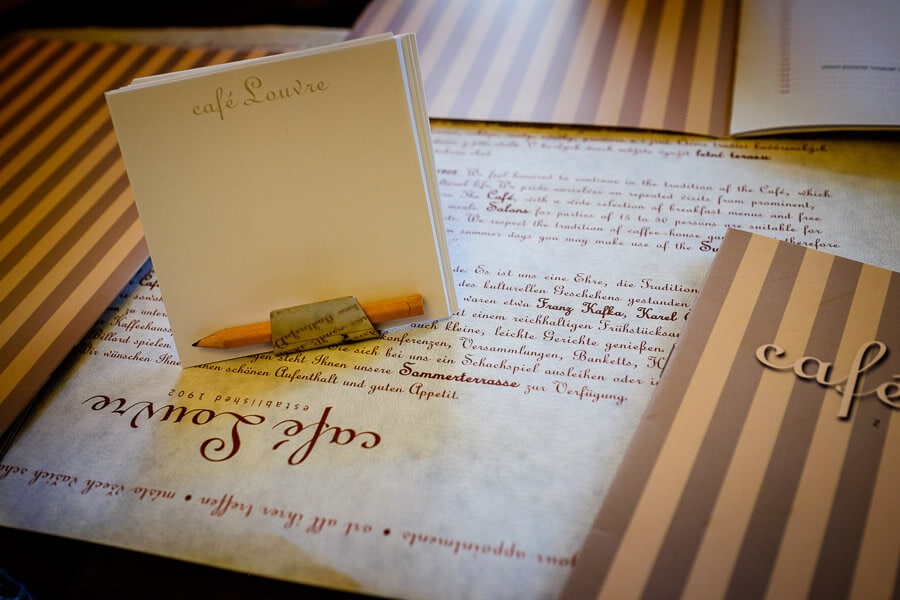
When it comes to cafes in Prague, there are few better places to experience the history of the city than Cafe Louvre, an iconic haunt of Albert Einstein and Franz Kafka.
The venue opened in 1902 and, as well as serving high-quality Czech food, it became a hangout for academics and writers. Sadly, it was forced into closure by the Soviet government who prohibited private businesses and the work of creative minds. After sitting empty for five decades, it opened to the public once more in 1992.
Today, it’s a fairly sophisticated place to eat food in Prague, but it’s by no means an unaffordable option. Visit for the gorgeous interior and period artwork, and stay for the hearty meals and selection of coffee, cocktails, wine and beer.
Order the Czech national dish, svickova, steak in a puree of carrots, parsley and celery, served with bread dumplings, cranberry sauce and finally, a squirt of cream! It sounds strange, but the combination somehow works.
Europe’s top coffee experiences
Sacher Café Wien | Vienna, Austria
By James Ian at Travel Collecting
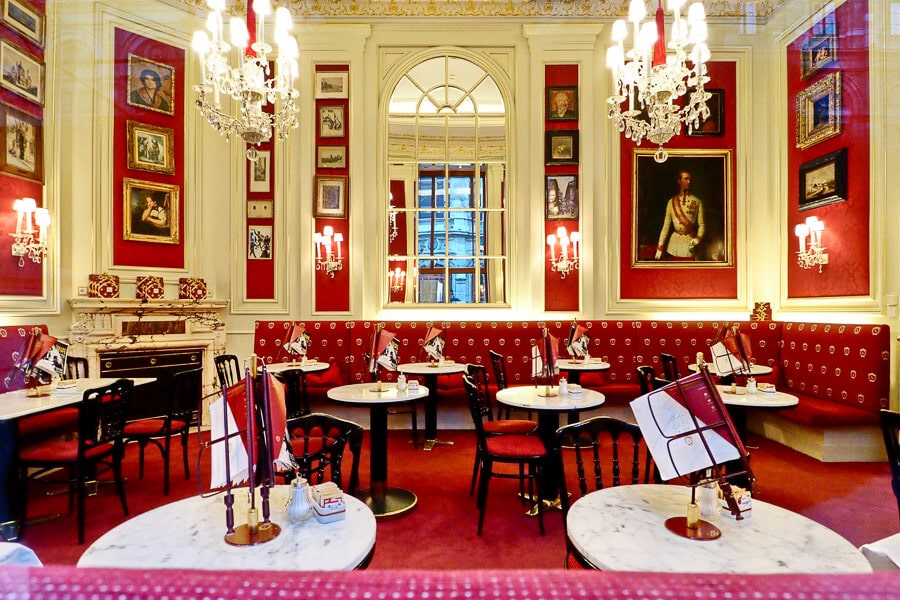
Another of the most iconic cafes in Europe is the Sacher Cafe Wien in Vienna. This is where the eponymous Sachertorte was invented.
Sachertorte cake – two layers of chocolate sponge cake separated by a thin layer of apricot jam and covered in a dark chocolate ganache – is without a doubt one of the most famous foods in Austria. It was created by pastry chef Franz Sacher in 1832 when he was just 16 years old.
Today, it’s served in the cafe at the famous Sacher Hotel. Choose from the lovely outdoor area, which is perfect for people watching on a summer day, or the indoor cafe.
The original recipe is protected by a trademark and jealously guarded, so the only place in the world to have a REAL piece of Sachertorte is right here. Each slice even comes with a trademark stamp – in chocolate, of course.
Best paired with a coffee or a chocolate liqueur, a slice of Sachertorte at the Sacher Cafe is something not to be missed when you visit Vienna.
Hafiz Mustafa | Istanbul, Turkey
Editor’s choice
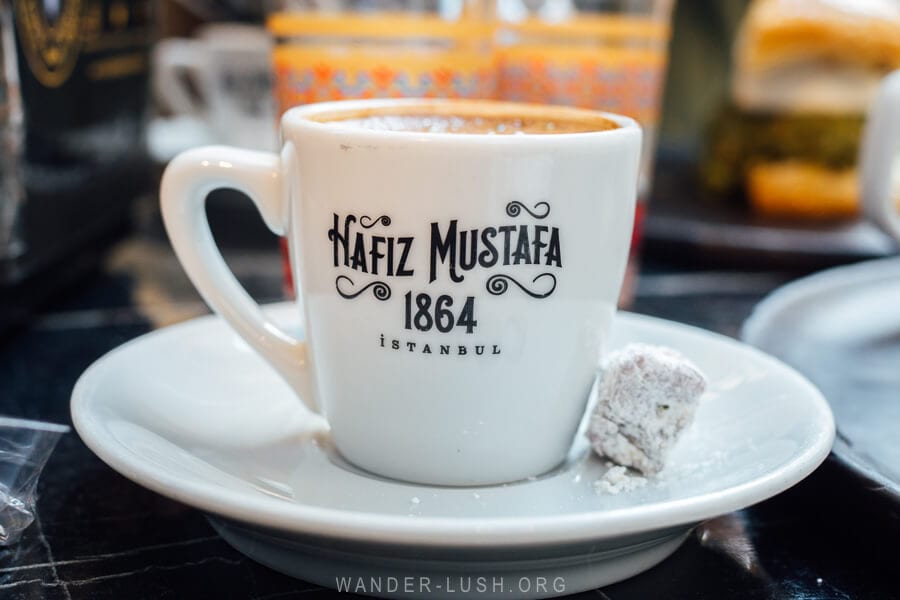
With its original branch located in the Sirkeci neighbourhood on the European side of beautiful Istanbul, Hafiz Mustafa is part of the crop of cafes where coffee made its cross-continental hop. It’s a wonderful place to sample traditional Turkish coffee and sweets.
The cafe and confectioner was established in 1864 by a merchant and his son. The latter of the duo is credited with inventing pogaca, a filled bun that’s been a mainstay of the menu throughout its five-generations of family ownership.
Today, there are a dozen branches of the cafe across Istanbul. For the original experience, head to the first shop on Hamidiye Street. The wallpaper-and-tile interior with veneered columns screams of the days when a family outing to Hafiz Mustafa must have been a real treat. You can see a framed portrait of the cafe’s founder, Ismail Hakki Zade, perched above the till.
Turkish coffee served from a cezve – a ritual drink so important it’s recognised as part of the Intangible Cultural Heritage of Humanity – is the thing to order here. Pair it with a slice of Hafiz Mustafa’s famous fruit cake, a few hard candies, or a square of Turkish delight.
My personal favourite item on the menu is booza baklava, an indulgent slab of chewy Turkish ice cream sandwiched inside a slice of pistachio baklava. It goes down a treat on a hot summer’s afternoon or a cold winter’s eve.
Conditori La Glace | Copenhagen, Denmark
By Derek & Mike at Everything Copenhagen

Copenhagen’s most iconic cafe is Conditori La Glace, an elegant establishment that dates back to 1870. They serve traditional tea, coffee, hot chocolate and of course Danish pastries and elaborate cakes.
Not only is La Glace the oldest bakery and confectioner in Denmark, but it’s also one for the best places to visit for breakfast in Copenhagen. In fact, it’s hard to walk by La Glace, look through the window and not stop in for something sweet. Denmark is famous for sweet breads and pastries and La Glace has been perfecting them for over six generations.
The interior of the cafe takes you back to a bygone era. With old-fashioned decor and staff uniforms, La Glace maintains all the charm of a 150-year-old family bakery.
Anyone visiting Copenhagen should plan a stop at this Danish institution. There are many options for pastries and coffee in the city, but none compete with the iconic taste, atmosphere and experience of Conditori La Glace.
Hotel Moskva Cafe | Belgrade, Serbia
Editor’s choice

The capital of former Yugoslavia is most often associated with concrete monoliths – but Belgrade has some truly splendid old buildings as well. The iconic Hotel Moskva on Terazije square is one example of Serbian Art Nouveau and is a complete contrast to the Socialist-Brutalist architecture that defines the newer part of the city.
Since it opened in to the public in 1908, the hotel has always had a public street-level kafana. Today, the cafe at Hotel Moskva serves more than 300 different cakes, but it’s famous for one recipe in particular, the eponymous Moskva Shnit.
This fruit and cream cake was invented in 1974 by the hotel’s pastry chef, Anica Dzepina, and has been trademarked ever since.
Delicately layered with with almonds, pineapple and cherries, Moskva Shnit is light and airy, perfect for eating on a summer’s day while you sit on the cafe’s sun-kissed terrace.
Osteria del Sole | Bologna, Italy
By Lori at Travlinmad

Just steps from the Piazza Maggiore in the historic heart of Bologna is the Quadrilatero, the oldest market in Bologna. Lining the narrow cobbled streets are jewellers, high-end apparel stores, butchers, delis, fish markets, produce stands, and bakeries. If it’s eaten in Bologna, you’ll find it here.
But there is something else very special here that happens to be one of the most unique things to do in Bologna.
Osteria del Sole is one of the longest operating cafes in the world. In existence since 1465, the comfy pub was frequented by university students and luminaries of the day, including Da Vinci and Galileo.
They don’t serve food, but you can purchase wine and beer. It’s easy to find great food in the shops nearby to accompany your drink. The Salumeria Simoni, a small cheese and salami shop in the heart of the market, is a great choice.
From there, walk a short distance up Via Ranocchi and look out for the small sign, Osteria del Sole. Find a place to sit, order a glass of wine, and break out your lunch.
This is a lively, social place, especially in the afternoons when locals and visitors alike come to enjoy good conversation and an aperitivo with friends. Oh, if only the walls could talk!
Caffe San Carlo | Turin, Italy
By Christina at Travel2Next

Caffè San Carlo can be counted among the most iconic European cafes as it’s been a meeting place for writers for centuries.
This is where French novelist and author of The Three Musketeers, Alexandre Dumas, tasted his first bicerin, a unique hot beverage created from layers of espresso, drinking chocolate and milk.
One of the most distinguished cities in Italy, Turin was the Kingdom’s first capital (before Florence and Rome) and attracted Europe’s literary and political community as a result. Several grand cafes were established to host these noteworthy visitors, none more beautiful than Caffè San Carlo.
The building sits in the famous Piazza San Carlo, right in the heart of Turin, where you can wander around and admire the city’s stately architecture. The interior is richly decorated with ornate gold-leaf mirror, marble and velvet.
Sitting inside the cafe and sipping on a glass of the city’s traditional hot drink is one of the things to do in Turin for your bucket list.
Bettys in Harrogate | Yorkshire, England
By Stuart Forster at Go Eat Do

Bettys operates six tea rooms across Yorkshire, but the first to open was in central Harrogate.
The cafe was established in 1919 by a Swiss immigrant who started life as Fritz Bützer. A successful confectioner, he anglicised his name to Frederick Belmont. That Swiss connection explains the speciality dish of bacon and raclette rösti, which still features on Bettys’ menu.
The best-known cafe in the spa town has become an iconic venue for traditional afternoon tea served on three-tiered cake stands. It’s possible to walk up and wait to be seated or reserve a table in the elegant Imperial Room on Bettys’ upper level.
There’s a distinctive Old World charm to the tea room on Parliament Street in Harrogate. Staff don uniforms not too dissimilar to those worn by servants in the television series Downton Abbey.
If you want to stock up for a picnic or buy cakes for later, Bettys has a shop as well.
Bewley’s Oriental Cafe | Dublin, Ireland
By Emer & Nils at Let’s Go Ireland
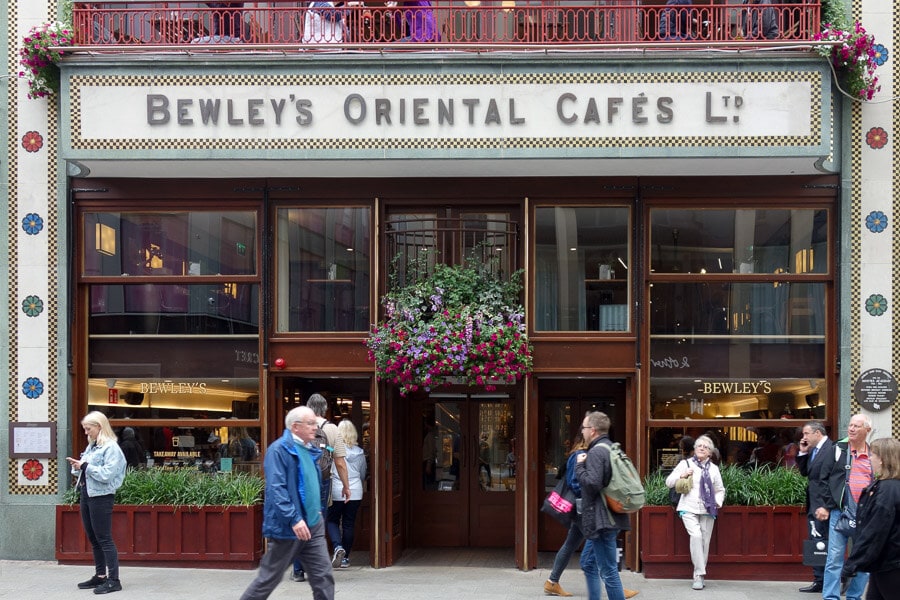
It would be difficult to list the most iconic European cafes without including the Dublin institution of Bewley’s Oriental Cafe on Grafton Street.
This cafe was designed with such great elegance and style that it continues to impress people more than 90 years after it first opened its doors.
The ground-breaking decor, including Egyptian-style motifs in colourful mosaic tiles covering the exterior of the building, is one of the more unusual sights of Dublin. However, it is the impressive stained glass windows, created by the renowned Irish artist Harry Clarke, that are the jewel in this cafe’s crown.
For some extra special ambience, visit the poets’ corner or the James Joyce room, or settle down beside one of the 10 open fireplaces to enjoy a freshly brewed coffee along with some delicious cakes and pastries. Don’t forget to try the original sticky bun!
There are also traditional Irish breakfast and light lunch options on the Bewley’s menu.
Cafe Central | Malaga, Spain
By Paulina at Paulina on the Road

One of the most iconic, beautiful and historic cafes in Spain is Cafe Central in the city of Malaga, located in the Plaza de la Constitución, only a 4-minute walk from the glorious Málaga Cathedral.
Jose Prado Crespo established this restaurant in the early 20th century in the days after the Spanish Civil War. Interestingly, it’s a combination of three smaller cafes: Café Suizo, Chinitas, and Munich.
The most special feature of Café Central is that it offers a splendid location to watch the world go by. If you’re wondering what to eat in Malaga, the cafe offers a diverse breakfast, lunch, dinner and tapas menu, alongside powerful solo and creamy nube coffee.
Friendly waitstaff and an English menu (with photographs of many dishes to accompany) make this a top place for freshly-prepared, great value eating for any visitor to Malaga.
Cafe Pedrocchi | Padova, Italy
By Jonathan at Journeymaxx

The Gothic Revival altars on the exterior of Cafe Pedrocchi hint at this cafe’s heritage. A popular meeting point for academics and writers since the 18th century, today, Padova’s most famous historic coffee house is also known for being one of the most canine-friendly, always going the extra mile to cater for patrons who wish to bring their dogs with them.
As with all the great coffee houses in Europe, it’s unique selling point is that the brew shares its name with the establishment itself. The Pedrocchi is a very dark blend served with mint cream and cocoa powder on top, which adds sweetness to counter the bitterness.
That’s all we know about the ingredients – the precise brewing method is confidential and all baristas are sworn to secrecy. Note that to appreciate the Pedrocchi’s taste, you are not supposed to stir it. So no spoons provided!
A popular urban legend says that students at Padua’s world-famous university must not enter the cafe until after they have graduated, else they be cursed with failure.
How many of these historic European cafes have you tried? Any other beautiful coffee shops in Europe that you’d add to the list? Let us know in the comments below!
More Europe inspiration
- Countdown of Europe’s best foodie experiences
- Where to go in Europe in fall – best wine harvest destinations
- The best destinations for couples in Spain or Greece
- Top 25 alternative European city break destinations
- 20 itinerary ideas for exploring Europe by train

Pastelaria Versailles in Lisbon also worth a visit.
It is superb!!!
In Greece there is a social media account which is called “Tsilli Coffee Shop”, which releases sarcastic memes and holds coffeehouse-level conversations, on the Greek sports news. So I think it should be included XD
Such a great list! I will have to visit them all! As a foodie I always love to hunt for the best places to eat when I travel, and historical places are even better!
I visited the New York Cafe in Budapest and it is stunning! Definitely one of my favorite experiences!
Great guide! Two of my fave things, coffee and history! 😂 New York cafe looks stunning but they’re all amazing and I’ve only been to 2 so far!
Wow! Each cafe is stunning in its own history and significance to the city’s attractions. The photographs are just so lively and capture the buzz of each place, making me long to head out there right now Emily. I loved going through this post 🙂
ooh I love this, it’s given me so many ideas for when I head back to Europe and I’m dying to go to Lviv. The only one I’ve been to is Florian in Venice, definitely a bucketlist list!!